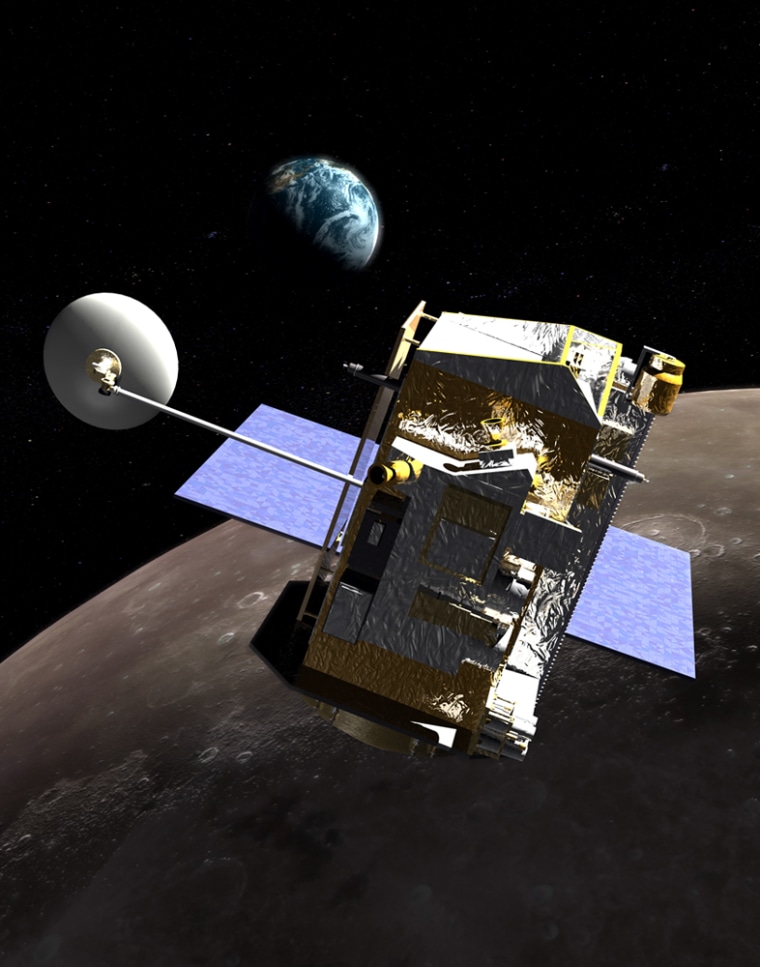A powerful robotic lunar scout, NASA's first in more than a decade, arrived at the moon early Tuesday on a mission to seek out potential landing sites and hidden water ice for future astronauts.
NASA's Lunar Reconnaissance Orbiter fired its thrusters at 5:47 a.m. ET in a 40-minute maneuver to begin orbiting the moon. It is NASA's first unmanned moon shot since 1998.
"We are in lunar orbit," LRO project scientist Richard Vondrak said at NASA's Goddard Space Flight Center in Greenbelt, Md. "We're not going past the moon. We're there to stay."
About the size of a Mini Cooper car, the $504 million LRO probe launched toward the moon on June 18 and spent four days in transit — about a day longer than astronauts on the Apollo missions in the late 1960s and early 1970s. The robotic probe is expected to spent at least one year mapping the moon for future manned missions, as well as several more years conducting science surveys.
"LRO has returned NASA to the moon," a flight controller said as NASA's LRO mission control center erupted in applause. The probe's lunar arrival came less than a month before the 40th anniversary of NASA's first moon landing by Apollo 11 astronauts on July 20, 1969.
The spacecraft carries seven instruments to map the moon in unprecedented detail, seek out water ice hidden in the permanent shadows of craters at the lunar south pole, and measure the temperature and radiation hazards that future astronauts may face. The names of 1.6 million people are also riding aboard LRO as part of a public outreach program.
LRO is currently circling the moon in an extremely elliptical orbit that brings the nearly 2-ton probe within about 124 miles (200 kilometers) of the lunar surface at its closest and reaches out to 1,863 miles (3,000 kilometers).
"It went like clockwork," said Craig Tooley, NASA's LRO project manager. "In the end, it went exactly as planned."
Over the next few days, more thruster firings should fine-tune the spacecraft's flight path until it reaches its planned observation orbit of between 31 and 135 miles (50 to 218 kilometers). Two of LRO's seven instruments, a pair of radiation sensors, scanned the space environment between Earth and the moon, with the remaining five instruments to be activated in the next few weeks.
The first images from the powerful camera aboard LRO should be beamed back to Earth in the next few weeks, mission managers said.
"This whole new moon we're ready to see is out there waiting, and this mission is going to go get it," said Jim Garvin, NASA's chief scientist at Goddard.
A second unmanned spacecraft, the $79 million Lunar Crater Observation and Sensing Satellite, also launched with LRO last week and made a slingshot maneuver past the moon later Tuesday. The spacecraft and an attached empty Centaur rocket stage flew by the moon and shifted into a polar orbit that will ultimately end in an Oct. 9 crash into a shadowed crater at the moon's south pole. The debris thrown up by the crash will be analyzed for signs of hidden water ice.
This report was updated by msnbc.com.
More on moon exploration | lunar ice
